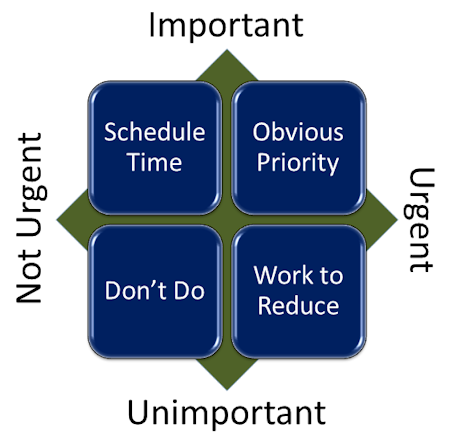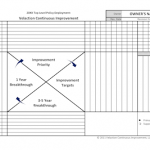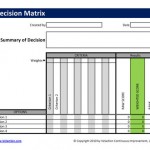Important vs. Urgent
People make decisions every day about what tasks to add to their schedule. They basically have two choices. They can do the important stuff, or they can take on the urgent stuff. Urgent things are due immediately, and often have people hounding the taskee to get them done. Important things are often related to “big picture” activities that don’t cause problems on a day to day basis. Because of this, there is generally nobody asking relentless questions about these sorts of issue. But the important things are critical for long term success.
It creates a dilemma for most people. They feel bad about rejecting a person’s pressing need, and instead working on something that is more important, but off on the horizon.
Sometimes, of course, the decision is easy. On occasion, you will encounter a task that is both important and urgent. Those are obvious priorities. Tasks that are neither important nor urgent obviously should receive no attention.

The first step to using your time effectively is to recognize what category your tasks fall into. Some people have an extremely hard time identifying the difference between urgent and important. Learning how to distinguish between the two is extremely important because not all urgent tasks should be worked on. Sometimes you will just have to say no.
In other cases, you may just have to tell the person that you won’t be able to get to it immediately. One of four things will happen.
- The person will find an alternative taskee. He will track down another person to do the work.
- The person will make an alternative plan. Goals can often be achieved in many different ways.
- The person will abandon the request.
- The person will come back again.
If number four happens, there is a chance that the task is actually important. Find out by applying a price tag to it. For example, offer to stay late with the person to work on it together, or request some prep work be done to help out with the project. The response will tell you how much value the requester really places on the work.
“And” Versus “Or”
Unfortunately, the sad reality is that we live in a world of “AND” rather than a world of “OR”. In all likelihood, you may not have the option to eliminate the urgent tasks. I recommend that you allocate time to do important tasks first, and let the urgent ones take up the leftover time. Work has a way of filling up available time (Parkinson’s Law). If you do it the other way around, working on the urgent tasks first, the important ones will be shortchanged.
Urgency Is a Red Flag
Urgent tasks are typically a sign of a failure. There are rare occasions where a last-minute problem or opportunity comes up that can’t be foreseen, but again, those are few and far between.
Most last minute issues can be traced back to some earlier error in a process. A critical order that needs to be placed to keep an assembly line from being shut down might be the result of a misplaced kanban card. An irate customer might be the result of a fax machine that jammed due to poor maintenance. An end of the month spike in orders to process likely comes from faulty sales policies.
The point is that every urgent task should be analyzed and tracked. That analysis should be the price of admission for working on the urgent problem. If you agree to drop what you are doing for a problem, the person asking for help should agree to do a countermeasure to make sure the issue never happens again. It is worth noting that many urgent taskers are repeat offenders. The same people seem to be the ones coming for last minute assistance, over and over. Make them realize that they have to contribute to a permanent process improvement if they want you to apply the band aid now.
The Theory of Relativity
Important and urgent are relative concepts at a macro level. What is important to one part of the organization may not matter to another part.
Importance at the company level, though, trumps what feels important to the individual departments. Clear policy deployment can help with this problem. How impactful an activity is on a PD item should be the deciding factor when determining if an activity is important or not.
KPI (key performance indicator) Bowlers are another useful tool for determining importance. Generally speaking, the more a task affects someone’s KPIs, the more important it is.
There are often, though, people who will try to use customer impact as the final decision factor. Be careful about immediately stressing the impact a project has on a single customer. Generally, PD items will have a broader effect on more customers than an issue affecting just one customer. That’s not to say poor customer service is OK. It just means that you should look at the big picture, so you don’t hurt many customers at the expense of one. (Note: sometimes there is a large customer that does warrant immediate attention. Act accordingly.)
Important vs. Unimportant Strategy
If you look at these two factors on a matrix, the strategy on how to handle things becomes clear.

- Important and Urgent: Do it first. This is an obvious priority.
- Unimportant and Not Urgent: Ask yourself why you would spend any time doing something that is unimportant and not a pressing task. This is not as rare as you might think. Many people do senseless activities out of force of habit.
- Important but Not Urgent: Keep in mind that important things will eventually be urgent if you keep putting them off. Schedule time on your calendar to guarantee you work on these.
- Urgent but Unimportant: Work to eliminate the root causes that led to the failure that made this become an urgent issue.
Watch our Decision Matrix Template video to gain insight into prioritization.

Words of Warning
- The requester of a task is not always someone else. Sometimes it is work that you create on your own. Take a close look at the tasks you are doing on a daily basis and see how much of it is really important to your job. We often fill our days with meaningless activity.
- Urgency expires. Sometimes, a good strategy is to delay a chronic offender until the point is moot. It is surprising how often an urgent but unimportant deadline passes without incident. Note: Get your manager’s support if you go this route, because there can be some backlash.
- Say “no” if an urgent task will derail a more important project. It can be difficult to do this, so have your ducks in a row about what will happen if you switch to the urgent task.

The closer you are to the frontline in an organization, the less control you will have in what you choose to do or not do. Instead of arguing with your boss about whether you should do something or not, put the requests into context.
Make a list of the tasks and projects you are working on and place them in priority order. Bring the list to your manager for review and make sure there is agreement. If someone comes to you asking for urgent help, and they won’t take no for an answer, talk to your boss for support. She will have a good idea of what is on your plate and will go to bat for you more readily if she has a clue what you are working on.
Unfortunately, bosses sometimes to put their employees in a tough spot. They help set priorities, but often change the plan when something urgent comes up. In addition to delaying the important jobs, it adds the waste of switching between tasks.
Navigating these challenges can be tricky. The best strategy is often to be direct, but respectful, about the situation. Ask to reschedule or eliminate an important deadline as urgent tasks creep into your workload. Track the time you spend on unplanned activity. And keep track of the urgent problems you are dealing with. This information comes in useful when working out new timelines with your boss and requesting support in improving the problems that are creating the urgent issues.

New leaders often have a hard time facing the fact that they do not have the resources to do everything. The answer to a request is often no. Managers who don’t learn to say no and to prioritize will find themselves chronically firefighting and never getting to fire prevention.
Track the time you spend on urgent tasks and on important tasks. Chances are you spend far more time on urgent, unimportant things than you think you do. If this is the case, you have a few strategies.
- Focus on empowering employees to make on the spot decisions. Urgent tasks often get worse when an employee has to track you down to handle a problem.
- Track the root causes of issues. The Pareto Principle will apply. You’ll find that the majority of the crises you face are about the same thing over and over and over. Fix the process and eliminate the crises. This has a secondary effect as well. People tend to be embarrassed about being a chronic offender. If they see that they are at the top of your list, they may be inspired to take action.
- Offer assistance but be clear that you will need help. This tactic won’t always apply, but most tasks have some work associated with them that can be done by the requestor. If someone won’t provide help that they can, it is an indicator about how urgent the task really is.

Key Points about “Important vs Urgent”
- People confuse important with urgent. Focusing on urgent actions stops short term pain and long-term gain.
- Urgent issues are nearly always a sign of a process failure. They should be accompanied by a countermeasure to prevent them from recurring.
- The better you manage the easy decisions, the more flexibility you will have when harder decision about important versus urgent tasks come up.
![]()
Start tracking every urgent request. Make sure it is clear that they are being treated as a problem. Use your leadership team as a resource to focus continuous improvement effort on removing the issues that pull you away from important tasks.
![]()
Velaction offers three tools that help manage the conflict between urgent and important.
Policy Deployment Matrix
 Policy deployment helps people throughout the organization know how what they are working on fits into the company’s strategy. The policy deployment matrix makes determining what is more important easier.
Policy deployment helps people throughout the organization know how what they are working on fits into the company’s strategy. The policy deployment matrix makes determining what is more important easier.
KPI Bowler
 The KPI Bowler highlights the important measures of a frontline group. It provides a quick check to make sure that the majority of what the team is working on relates to key drivers of success.
The KPI Bowler highlights the important measures of a frontline group. It provides a quick check to make sure that the majority of what the team is working on relates to key drivers of success.
Decision Matrix Template
 When there is no clear guidance, importance can be more of a challenge to determine. The decision matrix template comes in hand in these situations.
When there is no clear guidance, importance can be more of a challenge to determine. The decision matrix template comes in hand in these situations.


0 Comments